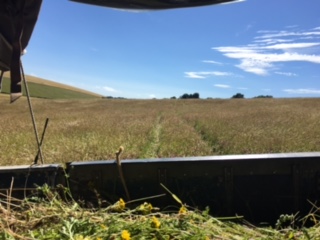Ragwort
My world has shrunk. I have learnt to make my way down down down where the iguanas play, for a reason that Dory Previn never envisaged. My gaze has shifted from the usual delighted scanning of a cerulean sky … groundwards. Star stained heights have lost their lustre and everything that is of interest […]
My world has shrunk.
I have learnt to make my way down down down where the iguanas play, for a reason that Dory Previn never envisaged. My gaze has shifted from the usual delighted scanning of a cerulean sky … groundwards. Star stained heights have lost their lustre and everything that is of interest has to be amongst the bleached August grasses that sway in the late summer breezes, down down down, at knee height or lower, where – if there are no iguanas – there are creatures enough to keep a lepidopterist or entomologist moderately content.
I have acquired new skills.
I have learnt to sense the foothills of the many and mighty ant mountains before I trip and fall, nests the size and height of which you would expect to find on an African savannah rather than a chalky downland landscape. I have learnt the feel of 50 different grass heads on the tips of my fingers. I have learnt to identify wild scabious and swoon over the orchids that populate the meadow. I can out-do John Cleese when it comes to silly exaggerated walks. You see, it is the ragwort time of year.
Ragwort – for those lucky enough not to have to identify it – is a yellow weed that grows in profusion pretty well everywhere. It has a bright, brassy, yellow, daisy-shaped flower on a coarse lattice-leafed stem. I am not sure whether it is intrinsically an ugly plant or whether I have come to see it as an ugly plant. It is highly toxic to all farm livestock and drives farmers of livestock to mania. You see it in scrubland choking out innocent nettles, on roadside verges as you go shopping , out of train windows on day trips to London and the central reservations of French autoroutes as you head to the Dordogne. The merest mention of it turns my children’s faces ashen and drives them swiftly metropolis-bound. It haunts us all.
, out of train windows on day trips to London and the central reservations of French autoroutes as you head to the Dordogne. The merest mention of it turns my children’s faces ashen and drives them swiftly metropolis-bound. It haunts us all.
You see, before we can make a bale of hay to feed our cattle and sheep over what may be a long cold winter, we have to stride the length and breadth of a given field to pluck every single last stem of this terrible plant out by its roots. “Out of the Land Rover!” shouts the Gangmaster as we reach today’s designated meadow and we, the gang – the naive, the financially desperate, the ones with gritted teeth or those of fierce, inexplicable loyalty – jump down, pull on our sweaty rubber gloves, and spread out across the field to meet our yellow nemesis. ‘It doesn’t look too bad ahead!” shouts the Gangmaster. The naive nod and look pleased. This will be easy! Home in a jiffy after all! But we old hands plunge into the gloom of bitter experience at these weasel words. We know there will be a ‘patch’ just ahead, out of sight, seeded last year on a spiteful wind, that will test the resolve of the hardiest picker. Both hands and all strength will be needed to pull up these monstrous stems with their deep mandrake roots. At the end of the day we’ll be parched and hungry and broken in spirit.
desperate, the ones with gritted teeth or those of fierce, inexplicable loyalty – jump down, pull on our sweaty rubber gloves, and spread out across the field to meet our yellow nemesis. ‘It doesn’t look too bad ahead!” shouts the Gangmaster. The naive nod and look pleased. This will be easy! Home in a jiffy after all! But we old hands plunge into the gloom of bitter experience at these weasel words. We know there will be a ‘patch’ just ahead, out of sight, seeded last year on a spiteful wind, that will test the resolve of the hardiest picker. Both hands and all strength will be needed to pull up these monstrous stems with their deep mandrake roots. At the end of the day we’ll be parched and hungry and broken in spirit.
And yet … just a few weeks ago we finished late, only finishing because the light was failing us. There was more than half the field still to comb but there were sheep still to looker up above us. We drove right up the hill, the Land Rover straining at the crazy gradient. But up there on top we found a different world and turning off the engine we sat in silence. The sheep-scattered landscape was dual lit by an early giant moonrise and the orange streaks of a dying sun. Up here was peace and tranquillity broken only by the bleat of a ewe and the scuffles of late summer lambs upending their mothers for a teat. I can be a little slow sometimes to remember what all the struggle is about.
is about.
It was quite dark when we left.
More events
-
Live Music from The Hot Club of Jevington
Date: April 26, 2024
From: 7.30 pm
Next concert at The Sussex Ox Friday 26th April 2024 -
Pub Quiz
Date: May 27, 2024
From: 8.00 PM
The next quiz is on Monday 27th May. Teams of up to 6, entry is £1 per person. Booking is essential.



